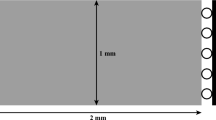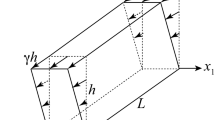Abstract
This paper studies the plane constrained shear problem for single crystals having one active slip system and subjected to loading in both directions within the small strain thermodynamic dislocation theory proposed by Le (J Mech Phys Solids 111:157–169, 2018). The numerical solution of the boundary value problem shows the combined isotropic and kinematic work hardening, the sensitivity of the stress–strain curves to temperature and strain rate, the Bauschinger effect, and the size effect.












Similar content being viewed by others
Abbreviations
- \(\beta \) :
-
Plastic slip
- \(\varvec{\sigma }\) :
-
Stress tensor
- \(\varvec{\varepsilon }\) :
-
Total strain tensor
- \(\varvec{\varepsilon }^\text {e}\) :
-
Elastic strain tensor
- \(\varvec{\varepsilon }^\text {p}\) :
-
Plastic strain tensor
- \(\chi \) :
-
Configurational temperature
- \(\chi _0\) :
-
Steady-state configurational temperature
- \(\gamma (t)\) :
-
Shear amount (as control parameter)
- \(\gamma _D\) :
-
Energy of one dislocation per unit length
- \(\mu \) :
-
Shear modulus
- \(\nu \) :
-
Poisson’s ratio
- \(\rho \) :
-
Total density of dislocations
- \(\rho ^\text {g}\) :
-
Density of non-redundant dislocations
- \(\rho ^\text {r}\) :
-
Density of redundant dislocations
- \(\tau \) :
-
Resolved shear stress (Schmid stress)
- \(\tau _\text {B}\) :
-
Back stress
- \(\tau _\text {T}\) :
-
Taylor stress
- \(\tau _\text {Y}\) :
-
Flow stress
- \(\varphi \) :
-
Angle between slip direction and \(x_1\)-axis
- \(\mathbf {m}\) :
-
Unit vector normal to the slip plane
- \(\mathbf {s}\) :
-
Unit vector showing the slip direction
- \(\mathbf {u}\) :
-
Displacement vector
- \(a^2\) :
-
The minimally possible area occupied by one dislocation
- b :
-
Magnitude of Burgers’ vector
- h, w, L :
-
Height, width, and depth of the slab
- q :
-
Dimensionless plastic strain rate
- \(q_0\) :
-
Dimensionless total strain rate
- T :
-
Kinetic-vibrational temperature
- \(t_0\) :
-
Time characterizing the depinning rate
- \(T_P\) :
-
Energy barrier expressed in the temperature unit
- Dot over quantities:
-
Time rates
- Bar over quantities:
-
Quantities averaged over the thickness
- Tilde over quantities:
-
Rescaled (dimensionless) quantities
References
Abbod, M.F., Sellars, C.M., Cizek, P., Linkens, D.A., Mahfouf, M.: Modeling the flow behavior, recrystallization, and crystallographic texture in hot-deformed Fe-30 Wt Pct Ni Austenite. Metall. Mater. Trans. A 38(10), 2400–2409 (2007)
Acharya, A.: New inroads in an old subject: plasticity, from around the atomic to the macroscopic scale. J. Mech. Phys. Solids 58(5), 766–778 (2010)
Anand, L., Gurtin, M.E., Reddy, B.D.: The stored energy of cold work, thermal annealing, and other thermodynamic issues in single crystal plasticity at small length scales. Int. J. Plast. 64, 1–25 (2015)
Ayers, J.E.: The measurement of threading dislocation densities in semiconductor crystals by X-ray diffraction. J. Cryst. Growth 135(1–2), 71–77 (1994)
Berdichevsky, V.L.: Homogenization in micro-plasticity. J. Mech. Phys. Solids 53(11), 2457–2469 (2005)
Berdichevsky, V.L.: Continuum theory of dislocations revisited. Contin. Mech. Thermodyn. 18(3–4), 195–222 (2006a)
Berdichevsky, V.L.: On thermodynamics of crystal plasticity. Scripta Mater. 54(5), 711–716 (2006b)
Berdichevsky, V.L.: Entropy of microstructure. J. Mech. Phys. Solids 56(3), 742–771 (2008)
Berdichevsky, V.L.: Beyond classical thermodynamics: dislocation-mediated plasticity. J. Mech. Phys. Solids 129, 83–118 (2019)
Berdichevsky, V.L., Le, K.C.: Dislocation nucleation and work hardening in anti-plane constrained shear. Contin. Mech. Thermodyn. 18(7–8), 455–467 (2007)
Berdichevsky, V.L., Sedov, L.I.: Dynamic theory of continuously distributed dislocations. Its relation to plasticity theory. J. Appl. Math. Mech. 31(6), 989–1006 (1967)
Bilby B (1955) Types of dislocation source. In: Report of Bristol Conference on Defects in Crystalline Solids (Bristol 1954, London: The Physical Soc.), pp. 124–133
Calcagnotto, M., Ponge, D., Demir, E., Raabe, D.: Orientation gradients and geometrically necessary dislocations in ultrafine grained dual-phase steels studied by 2d and 3d ebsd. Mater. Sci. Eng. A 527(10–11), 2738–2746 (2010)
Follansbee, P.S., Kocks, U.F.: A constitutive description of the deformation of copper based on the use of the mechanical threshold stress as an internal state variable. Acta Metall. 36(1), 81–93 (1988)
Groma, I., Csikor, F., Zaiser, M.: Spatial correlations and higher-order gradient terms in a continuum description of dislocation dynamics. Acta Mater. 51(5), 1271–1281 (2003)
Hochrainer, T.: Thermodynamically consistent continuum dislocation dynamics. J. Mech. Phys. Solids 88, 12–22 (2016)
Kröner, E.: Der fundamentale zusammenhang zwischen versetzungsdichte und spannungsfunktionen. Z. Phys. 142(4), 463–475 (1955)
Kröner, E.: Kontinuumstheorie der Versetzungen und Eigenspannungen, vol. 5. Springer, New York (1958)
Langer, J.S.: Statistical thermodynamics of strain hardening in polycrystalline solids. Phys. Rev. E 92(3), 032125 (2016)
Langer, J.S., Le, K.C.: Scaling confirmation of the thermodynamic dislocation theory. Proc. Natl. Acad. Sci. USA 117(47), 29431–29434 (2020)
Langer, J.S., Bouchbinder, E., Lookman, T.: Thermodynamic theory of dislocation-mediated plasticity. Acta Mater. 58(10), 3718–3732 (2010)
Le, K.C.: Thermodynamic dislocation theory for non-uniform plastic deformations. J. Mech. Phys. Solids 111, 157–169 (2018)
Le, K.C.: Two universal laws for plastic flows and the consistent thermodynamic dislocation theory. Mech. Res. Commun. 109, 103597 (2020a)
Le, K.C.: Introduction to Micromechanics. Nova Science, New York (2020b)
Le, K.C., Piao, Y.: Thermodynamic dislocation theory: size effect in torsion. Int. J. Plast. 115, 56–70 (2019)
Le, K.C., Sembiring, P.: Analytical solution of plane constrained shear problem for single crystals within continuum dislocation theory. Arch. Appl. Mech. 78(8), 587–597 (2008)
Le, K.C., Stumpf, H.: A model of elastoplastic bodies with continuously distributed dislocations. Int. J. Plast. 12(5), 611–627 (1996)
Le, K.C., Tran, T.M.: Thermodynamic dislocation theory: bauschinger effect. Phys. Rev. E 97(4), 043002 (2018)
Le, K.C., Tran, T.M., Langer, J.S.: Thermodynamic dislocation theory of high-temperature deformation in aluminum and steel. Phys. Rev. E 96, 013004 (2017)
Le, K.C., Tran, T.M., Langer, J.S.: Thermodynamic dislocation theory of adiabatic shear banding in steel. Scripta Mater. 149, 62–65 (2018)
Levitas, V.I., Javanbakht, M.: Thermodynamically consistent phase field approach to dislocation evolution at small and large strains. J. Mech. Phys. Solids 82, 345–366 (2015)
Lieou CK, Bronkhorst CA (2020) Thermodynamic theory of crystal plasticity: formulation and application to polycrystal FCC copper. J. Mech. Phys. Solids 103905
Marchand, A., Duffy, J.: An experimental study of the formation process of adiabatic shear bands in a structural steel. J. Mech. Phys. Solids 36(3), 251–283 (1988)
Morito, S., Nishikawa, J., Maki, T.: Dislocation density within lath martensite in Fe–C and Fe–Ni alloys. ISIJ Int. 43(9), 1475–1477 (2003)
Mura, T.: Continuous distribution of dislocations and the mathematical theory of plasticity. Phys. Status Solidi B 10(2), 447–453 (1965)
Nye, J.: Some geometrical relations in dislocated crystals. Acta Metall. 1(2), 153–162 (1953)
Ortiz, M., Repetto, E.: Nonconvex energy minimization and dislocation structures in ductile single crystals. J. Mech. Phys. Solids 47(2), 397–462 (1999)
Po, G., Huang, Y., Ghoniem, N.: A continuum dislocation-based model of wedge microindentation of single crystals. Int. J. Plast. 114, 72–86 (2019)
Samanta, S.K.: Dynamic deformation of aluminium and copper at elevated temperatures. J. Mech. Phys. Solids 19(3), 117–135 (1971)
Shi, H., McLaren, A.J., Sellars, C.M., Shahani, R., Bolingbroke, R.: Constitutive equations for high temperature flow stress of aluminium alloys. Mater. Sci. Technol. 13(3), 210–216 (1997)
Weertman, J.H.: Dislocation Based Fracture Mechanics. World Scientific Publishing Company, Singapore (1996)
Author information
Authors and Affiliations
Corresponding author
Ethics declarations
Conflicts of interest
On behalf of all authors, the corresponding author states that there is no conflict of interest.
Additional information
Publisher's Note
Springer Nature remains neutral with regard to jurisdictional claims in published maps and institutional affiliations.
Rights and permissions
About this article
Cite this article
Günther, F., Le, K.C. Plane constrained shear of single crystals. Arch Appl Mech 91, 2109–2126 (2021). https://doi.org/10.1007/s00419-020-01872-3
Received:
Accepted:
Published:
Issue Date:
DOI: https://doi.org/10.1007/s00419-020-01872-3




